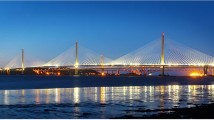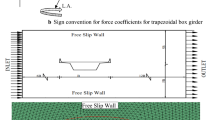Abstract
It has been demonstrated by mathematicians using nonlinear simplified models of suspension bridges that a vertical dynamic forcing can cause large torsional vibrations due to geometric nonlinearities of the bridge. Compared to the extensive research that has been conducted on aeroelastic instabilities in cable-supported bridges, the approach used by the mathematicians seems too simplistic, especially in terms of wind load modeling. However, they raise a point that is not considered in the wind design of cable-supported bridges, i.e., an interaction between nonlinear structural coupling and aeroelastic effects. In order to study the effect of structural geometric nonlinearities on the dynamic stability of very long cable-supported bridges, a special wind tunnel procedure was developed. Such procedure requires the development of a new experimental apparatus for section model tests of bridges that allows the representation of geometric nonlinearities and nonlinear structural coupling. Therefore, one of the first steps toward nonlinear section model tests was to design a new bridge rig for dynamic section model tests, which first needed to be validated for standard linear tests. Consequently, this paper will present a comparison of wind tunnel results for a single-box girder bridge model tested in two different wind tunnels, i.e., the main wind tunnel at the Université de Sherbrooke and the Boundary Layer Wind Tunnel Laboratory (BLWTL) at the University of Western Ontario. At the BLWTL, tests were conducted using the existing bridge rig and the new bridge rig designed for nonlinear tests. At first, the static aerodynamic coefficients and the flutter derivatives are compared. Then, the dynamic responses for smooth and turbulent flows obtained using the different experimental setups are analyzed. This comparison procedure allows the validation of the new bridge rig that will be used in the near future to assess the effect of structural nonlinearities on aeroelastic stability.
Access this chapter
Tax calculation will be finalised at checkout
Purchases are for personal use only
Similar content being viewed by others
References
Arioli G, Gazzola F (2017) Torsional instability in suspension bridges: the Tacoma narrows bridge case. Commun Nonlinear Sci Numer Simul 42:342–357
Bartoli G, Contri S, Mannini C, Righi M (2009) Toward an improvement in the Identification of bridge deck flutter derivatives. J Eng Mech 135(8):771–785
Brancaleoni F, Diana G, Fiammenghi G, Firth IPT, Gimsing NJ, Jamiolkowski M, Sluszka P, Solari G, Valensise G, Vullo E (2010) The Messina Strait bridge: a challenge and a dream. CRC Press/Balkema, Leiden, Netherlands
Capsoni A, Ardito R, Guerrieri A (2017) Stability of dynamic response of suspension bridges. J Sound Vib 393:285–307
Davenport AG, King JPC, Larose GL (1992) Taut Strip model tests. Aerodynamics of Large Bridges, Balkema, Copenhagen, Denmark, pp 113–124
Gimsing NJ, Georgakis CT (2012) Cable supported bridges: concept and design, 3rd edn. John Wiley & Sons, West Sussex, UK
Hjorth-Hansen E (1992) Section model tests. Aerodynamics of Large Bridges, Balkema, Copenhagen, Denmark, pp 95–112
Hussain N, Falbe-Hansen K, Kyte S (2010) Stonecutters bridge, Hong Kong: design and construction. Arup and COWI, Hong Kong
Irwin PA (1992) Full aeroelastic model tests. Aerodynamics of Large Bridges, Balkema, Copenhagen, Denmark, pp 125–135
Maheux S (2017) Simulation Dynamique du Flottement d’un Pont Élancé à l’Aide de Coefficients Instationnaires Temporels. Master’s Thesis, Université de Sherbrooke, Sherbrooke, QC, Canada
Maheux S, King JPC, El Damatty A, Brancaleoni F (2020) Assessment of nonlinear structural vertical-torsional coupling in cable-supported bridges. Eng Struct 219:110800
O’Neil T, Strganac TW (1998) Aeroelastic response of a rigid wing supported by nonlinear springs. J Aircr 35(4):616–622
Schwartz M, Manzoor S, Hémon P, de Langre E (2009) By-pass transition to airfoil flutter by transient growth due to gust impulse. J Fluids Struct 25(8):1272–1281
Skyvulstad H, Argentini T, Zasso A, Øiseth O (2021) Nonlinear modelling of aerodynamic self-excited forces: an experimental study. J Wind Eng Ind Aerodyn 209:104491
Zhang WM, Ge YJ (2014) Flutter mode transition of a double-main-span suspension bridge in full aeroelastic model testing. J Bridg Eng 19(7):06014004
Zhang WM, Quian KR, Ge YJ (2021) Research on flutter-mode transition of a triple-tower suspension bridge based on structural nonlinearity. Structures 34:787–803
Zhu LD, Gao GZ, Zhu Q (2020) Recent advances, future application and challenges in nonlinear flutter theory of long span bridges. J Wind Eng Ind Aerodyn 206:104307
Acknowledgements
The financial support of the Natural Sciences and Engineering Research Council of Canada (NSERC), the Fonds de recherche du Québec—Nature et technologies (FRQNT), the ministère des Transports du Québec, Mitacs, the Boundary Wind Tunnel Laboratory (BLWTL) at the University of Western Ontario, the Faculty of Engineering at the University of Western Ontario, COWI North America Ltd. as well as the Mensa Canada Scholarship Program was greatly appreciated for the realization of this research.
The authors would like to acknowledge the excellent work of the University Machine Services at the University of Western Ontario for the fabrication of the experimental apparatus utilized for this research project. The authors are thankful to Mr. Peter Case, Dr. Lingzhe Kong, Mr. Anthony Burggraaf and Mr. Andrew Klazinga for their assistance during the wind tunnel tests conducted at the BLWTL. For providing the bridge model utilized for this research project, the authors would like to thank Prof. Sébastien Langlois of the Université de Sherbrooke.
Author information
Authors and Affiliations
Corresponding author
Editor information
Editors and Affiliations
Rights and permissions
Copyright information
© 2023 Canadian Society for Civil Engineering
About this paper
Cite this paper
Maheux, S., King, J.P.C., Damatty, A.E., Brancaleoni, F., AbuGazia, M. (2023). Comparison of Wind Tunnel Results for the Development of a New Section Model Test Rig for Bridges. In: Gupta, R., et al. Proceedings of the Canadian Society of Civil Engineering Annual Conference 2022. CSCE 2022. Lecture Notes in Civil Engineering, vol 348. Springer, Cham. https://doi.org/10.1007/978-3-031-34159-5_59
Download citation
DOI: https://doi.org/10.1007/978-3-031-34159-5_59
Published:
Publisher Name: Springer, Cham
Print ISBN: 978-3-031-34158-8
Online ISBN: 978-3-031-34159-5
eBook Packages: EngineeringEngineering (R0)




